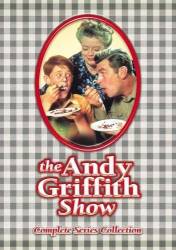Mayberry Goes Hollywood - S1-E13
Revealing mistake: When Andy is listening to the Hollywood producer talking about how he wants the town back the way it was before, over Andy's shoulder the "window" in one of the stores is blowing in the wind.

Starring: Ron Howard, Don Knotts, Andy Griffith, Frances Bavier
Mayberry Goes Hollywood - S1-E13
Revealing mistake: When Andy is listening to the Hollywood producer talking about how he wants the town back the way it was before, over Andy's shoulder the "window" in one of the stores is blowing in the wind.

Visible crew/equipment: When Otis tries to escape from Aunt Bee's clutches by hiding in the laundry service van, just as Aunt Bee has the driver open the van's back doors we can see the reflection of the moving boom mic in the left window.
Opie's Group - S8-E9
Andy: Clara, sometimes a parent can't see what he should do, and sometimes it takes a person from the outside to show him. And I'd like to thank you.
Clara: Groovy.
Trivia: Jack Dodson, who later played Howard Sprague, was originally cast to play Ed the Insurance man in an earlier episode called "Lost and Found".
Question: Why is it when they were on the show the Darling sons never spoke? Would they be paid more if they did, or was this some sort of joke?
Separate from membership, this is to get updates about mistakes in recent releases. Addresses are not passed on to any third party, and are used solely for direct communication from this site. You can unsubscribe at any time.
Check out the mistake & trivia books, on Kindle and in paperback.
Answer: It was a joke. They were supposed to be dumb hillbillies.
Both. According to later interviews with both Andy and the Dillards band (the real name of the band that played the parts of the Darling children, of which Charlene (Maggie Peterson - Mancuso was also a member) the reason the Darling boys never had any lines was because they would've had to have been paid if they spoke. In return for appearing without lines or pay, Andy promised to get as much of their music onto the show as possible which, he did. This obviously gave them a lot of exposure.